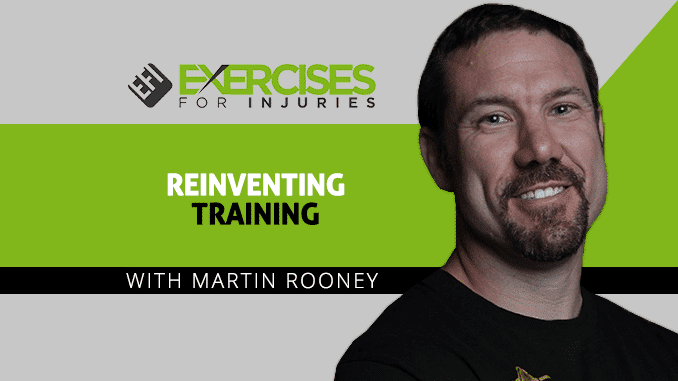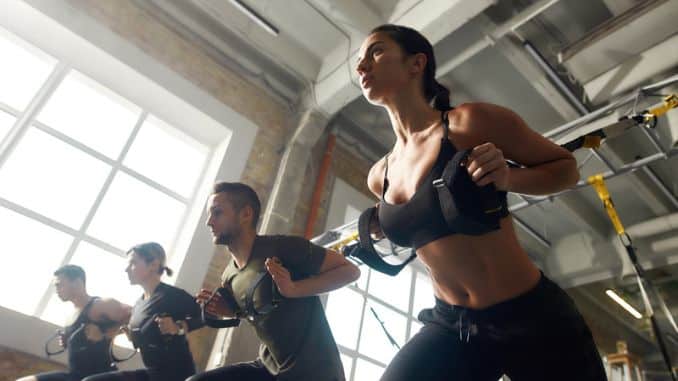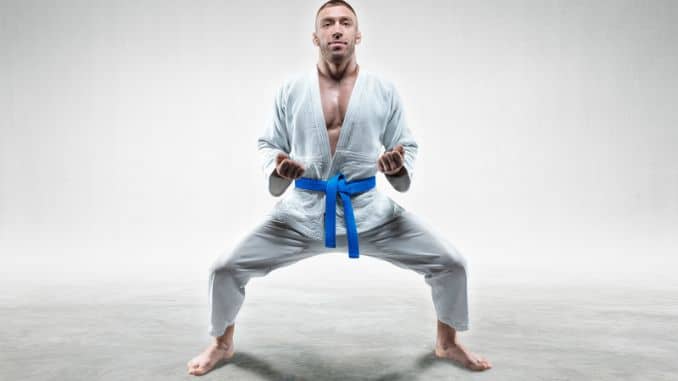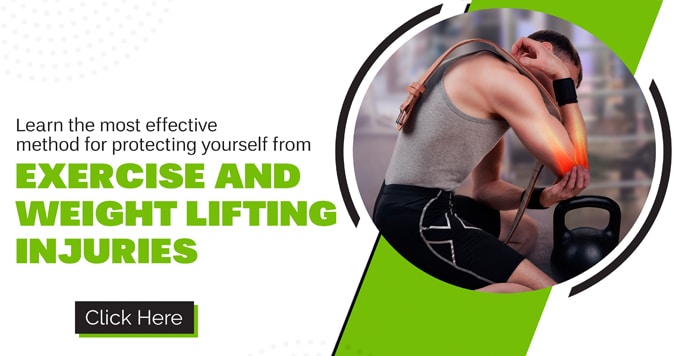
Yesterday, I took my kids over to my mom and dad. While driving over there, the kids fell asleep, so I went for a drive and let them sleep a little longer. I decided to head to the street that I grew up on. The street is still the same as all the original houses; the trees on the street are a lot bigger,r and the house I grew up in is still an army truck green. While driving, I thought about changing and growing, which is fitting for today’s interview. I have an interview that I did with Martin Rooney on Reinventing Training. It was great to reflect on that time and all those memories.
Amazing interview.
If you enjoy the interview, check out a few other videos from Martin here.
Rick Kaselj, MS
P.S. – While checking email, listen to the interview I did with Martin. It was great.
Reinventing Training with Martin Rooney
Rick Kaselj: Hey! This is Rick Kaselj from ExercisesForInjuries.com. Today I got another interview for you, and it’s with the one and only Martin Rooney.
Now, if you don’t know who Martin Rooney is, I know after this interview, you will know Martin Rooney, and he will burn a small spot in your mind after this interview.
Martin, for those who don’t know who you are, if you’re going to do a brief introduction on who you are.
Martin Rooney: Hey Rick. Thanks for having me on, and it’s my pleasure being here to share with everybody. For everybody that’s not familiar with me, hey! I am Martin Rooney.
For the last 20 years, I’ve been involved with fitness, and before that, I was an orthopedic physical therapist looking for something to do with my life.
It wasn’t my passion; it wasn’t the thing that I knew I wanted to be the best in the world, and sports, had always been really big for me. I was a track and field athlete in college, I was on the US bobsled team for several years, and I wanted to get back into fitness, to make an impact and help more people.
Bill Parisi and I start Parisi Speed School. The programming is across the United States, with over a million kids using the programming I created during that span. I also worked with high-level fighters and several professional athletes in different sports.
Training for Warriors
I started to create another program called Training for Warriors, which, although it was born from martial arts, now has over 80 facilities worldwide and hundreds and thousands of books sold. It has become this thing of a huge demand that I am now excited about every weekend I travel somewhere to share with others.
Rick Kaselj: Probably the first question that people will be asking is, have you always had this much energy and enthusiasm or was there an accident or incident that will flip this switch?
Martin Rooney: There is no accident; I would say there is a simple explanation for that, Rick, which is when you do what you love and what you are supposed to be doing, you will have super high energy. If you want to see me with low energy, take me to Ikea, take me to an auto body shop, or talk to me about window treatments, and you know what you’re going to see is really low energy in me.
When people find that connection between their passion and their purpose, that’s when the boundless energy is going to be there. It’s funny because I get that question a lot now, and I have to think about it for a while and get that answer.
I said I love what I am doing. So, man, you know I talked to you about this, I raced home from training classes to get to this interview so we could do it because I know more people are going to benefit from the energy, and it excites me to do that, but yeah there had been no accidents; it’s all been by design.
I will say this to everybody listening – hey; high energy will never fail you. You can’t be a ten, or you can’t want to make somebody a ten, and you’re a 2. If you’re going to be a 10, you got at least the chance to bring somebody up to a 5 or 6. So, I will always err toward higher energy and being on fire.
Rick Kaselj: Awesome. So we’re doing this interview as we want to get the message on improving trainers out there, and maybe we kind of start off with looking at the mistakes trainers make.
Common Mistakes in Training Industry
As you said, you teach your courses every weekend, and then I know your conferences. What kind of a mistake did you see in the fitness industry that trainers are making?
Martin Rooney: Well, that’s another great question, and right now, what I’ve been teaching a lot about, I guess one of the hot topics in the industry is metabolic training. And right now, whether we want to call it boot camps or we want to talk about Crossfit or P90x or any of these systems before you can even say it about mine, Training for Warriors.
There’s a metabolic training component that many people have, although now, we are starting to become familiar with the hard work behind it. Right now, the only way many of these sessions are measured is by the amount of fatigue it produces, the amount of soreness it produces, or if it’s just new and cool stuff people haven’t seen. I say that it’s really like the wild west.
The biggest mistake is that people forget that people are there to get results, and we’ve got to make sure that no matter what we are doing, we are using the most effective and safe methods to produce those results; which when I challenged a lot of people, I say “hey, what’s your job description” and people will say “my job description is to change lives, my job is to motivate, my job is to get people on fire” and I say “no, no, no.” Your job is to help people lose weight, build muscle, and feel good. That’s your job.
So many people don’t understand that job description; they miss what they are trying to achieve. I am not saying people cannot get sore or tired of your program, but that can’t be the only thing we see as valued right now. I might say that’s the biggest mistake, and not only because it hurts results, but the big breakthrough I had just the last couple of weeks is, you know what?
I’m doing charity events every weekend, and wherever I go, I’m doing a charity banner, or when I’m here, still in town, I’m doing charity events. I started to see such apprehension from these people that I started to ask questions before we began, and I would say, is anybody here nervous or scared to exercise?
And at the end, everyone’s hand would go up. Is everybody terrified? They say, “yeah,” I see what’s happening in exercise, now are you going to kill us? What are you going to do to us? What I want to do is to make a big shift in people’s minds that you know what? Those people should be afraid of what fast food and a sedentary lifestyle are doing to us, which kills people.
Exercise is not Tough.
Exercise doesn’t kill people; exercise buys you time, buys you time. Unfortunately, I think even with exercise. We are creating this environment that’s scaring people away that we need to save.
In the short answer, we are using these exercises to beat people up and create more of a beat down instead of measuring things. Maybe we are helping some people, these ex-athletes, the competitive people, and that’s fun, but there are hundreds and millions of people around the world right now that need our help, and we are scaring them away with exercise because it’s too tough. After all, we forget what we are trying to do is not the best way to do it.
Rick Kaselj: That’s a really good point is you look, I mean Crossfit has unleashed that old athlete in individuals, but you look at Richard Simmons who’s engaging people in moving. You can have whatever perception you want of him, and his techniques or like Curves but both of them tried to get those sedentary people moving; that’s an excellent point that we have to rekindle that athlete in us but also get those people going and moving.
Martin Rooney: Absolutely. What you just described, I talk about Richard Simmons all the time for everybody listening; he is on tour for two hundred and fifty days. He is estimated to help people lose 10 million pounds, and as you said, just like Crossfit, we can try to say bad things about them. They identified and marketed. They got people interested in exercise. They’ve created a community. We have to love them for that. There are many ways to do that other than bearing people with hard workouts. That is one thing that I am trying to pioneer today.
Training for Warriors Benefits
Rick Kaselj: Okay. That leads us to the things you’re known for, other than your high energy, which is the Training for Warriors thing. Maybe you give us where it started, what it is, and why it benefits trainers.
Martin Rooney: It’s a pretty need a lot of people these basic questions that I get all the time and Training for Warriors I like to talk about the most of late, is that Training for Warriors grew organically. What I mean is I was training world-class athletes, and my job was to make them world champions, and that was it.
I never saw what Training for Warriors is today, for that was what it will become. I think that the purity of that message is what gives it strength where I was never sitting around the marketing team or investment dollars and saying hey, we’ll create this thing that will trick people into exercising.
Training is an Art
What it was, is I created results that attracted. I eventually realized anybody could have it. It was not reserved for world-class athletes, but I realized people were missing the philosophical and personal development components that can also come along with fitness.
My background was also in martial arts, with a black belt in Judo and a purple belt in Jujitsu. And I’ve trained alongside some of the best martial artists in the world. What I realized was I wasn’t enjoying martial arts to beat someone. And also, I was doing martial arts to defeat myself, conquer my fear, to see how disciplined I could become in the face of the rest.
I started to think, can fitness do that? So what Training for Warriors essentially did is. I removed the punches and kicks, put in exercises, and am trying to make it an art. An art that not only changes people for 2 or 3 hours. They are with you for a week, but it changes you for the 165 hours they are not with you because that is where the real results will happen.
What started as just seminars, certifications and certifications turned into people running the programming. And now, like I said, in a short period. We got 80 facilities in a dozen worldwide countries running the system. About that, what I created 15 years ago impacts people I would have never met. Helping people every day, and that’s why I am super excited.
Where I used to get that rush from being in the ring with the UFC fighter and watching my guys win, now I get that same rush when somebody writes me. And says, “hey, Martin, I lost 60 pounds. I’m off medication, and I want to tell you that your program. It’s not what it did for me on the outside. But it’s what it did for me on the inside, and I want to thank you for that.”
The more that those are coming in, it feeds this machine of energy even more. And I leave a legacy behind for people after I am gone. So, that’s the trick on Training for Warriors.
Rick Kaselj: Okay. I like the physical component but then also the emotional component. I realize more than most people do and realize that’s a hidden power that brings out people.
Martin Rooney: Absolutely. Our tagline, we’ll you just said it’s funny, and I said bring it out.
Training for Warriors is Bring out the Warrior Within
I believe you don’t have to be a fighter to be a warrior. And you don’t have to get punched in the face to be tough.
Everybody’s got a warrior inside. There is the housewife. She has banged the alarm clock and care of the kids and still gets that workout. And there are weekend warriors that are going to play their sports.
Everybody’s got these incredible challenges, but where is that place where people can become stronger? Where is that place where somebody tells something good about themselves as they go? There’s a message they can learn from, and today it’s not at people’s work, and a lot of times, it’s not in their homes.
What I have always given a message to all the people that are working within my company is that. We will be that place for people and help them bring out the warrior within.
Rick Kaselj: Okay. And then, you know how Training for Warriors differs from all certifications. You know, I sometimes know what happens with me is that another certification is out, and I have it all in my eyes. How is yours different? What makes it so special?
Martin Rooney: What I would say, and I’ll answer that with a couple of things because I agree with you, Rick. My background, as everybody knows, is I got 3 degrees. And I’ve got 50 certifications in different advanced courses that I got too.
In some ways, the term certification has more than what started as a clinic. Then linked to a workshop then became a seminar. And now things are called certifications. I don’t have any problem with the syntax behind that. As long as we continue to learn what they want to call it. For instance, you and I are physical therapists, and when I got my physical therapy degree. The only degrees they offered 20 years ago were bachelor’s degrees. Then they started making the same course for master’ Degrees. It’s the same course, but now you’re called a doctor.
Somebody else called the doctor because they changed the syntax of the course, not me. When we say certification, here’s where I look at it. Every certification if you go and you only got something special from it. You got a sense of accomplishment; you studied, did your work, passed the exams, and accomplished that. You deserve it. And I don’t think anybody should have a problem with what’s happening. Or that it shouldn’t have any merit.
Two Things to Remember
What I want to say is what separates mine from others, and I’ve completed over 50 of these in the last two years around the world, is that people say two things.
1. It was an experience. You’ve seen me, and you’ll have a little taste of our experience. You know what? I received so many emails from that because people had an experience. It wasn’t just about technical training, and it wasn’t just about the system.
With my training and certification, you’ll learn about yourself. Everybody is going to be different. But when we did the first version of the online course. More people would mean it wasn’t about exercise; it was about Martin. You’ve invigorated me, Martin. You reminded me why I am in fitness again. And what I needed to do and got me back on track. I would say it’s an experience.
2. The word that I keep hearing over and over from people when they talk to me, they say “It’s authentic.” They say, “it’s the truth.” Like what you’re preaching about there is real. It’s not; there are no tricks, ways, upsells, or anything else. It’s authentic information that came from a pure source.
That would be the only way that I would want it described. And the way that I want to come across. I would say if people spend 15 straight hours with me over two days. They are going to be different people when they end that course. I’ve been to a lot of courses where that doesn’t happen. So I know how they give a bad course. And I know how to give a good course or certification, whichever way you want to call it.
No one in a thousand of those twelve hundred people going through the course. I even had one person say they got something great from it.
That is the end of part 1; I will be back with part 2





